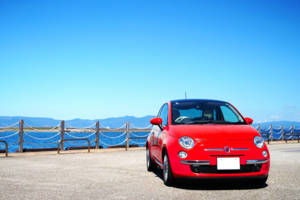How to Get Around in Japan
Saturday, October 12, 2019
Everything you need to know about transportation in Japan

When living or working in Japan, one big priority will be finding the perfect method of transportation for you. There are a ton of options available. In this article we’ll go over the commonly available methods of transportation, their pros and cons, and the costs.
This article will cover: Bicycles, Cars, Trains, Busses, Motorcycles & Scooters, and Trams

Bicycle
In Japan, 78% of households own bikes for some reason or another. 15% of commuters require a bike for some or all of the trip. If you live in the city, a bike will be particularly helpful. Once you’ve got your bike, all you have to do is pay a small registration fee at the store and you’re ready to go.
The most common bicycle you’ll find in Japan is the “mamachari,” (mom bike) so named because many mothers will attach one or two child seats on these bikes to take their children wherever they need to go. This is the bike that you’ll probably be buying, unless you’re riding for sport or exercise rather than for daily life.
Mamachari: Bike features
Comes with a lock
Comes with a light (For a slightly higher price, you can have a light that will automatically turn on and off depending on the time of day. Handy, because lights are a requirement, and if you’re riding at night without them, you WILL be stopped by the police.)
Usually comes with a basket (Useful for groceries)
Cost
A cheap, new mamachari might cost you anywhere from 15,000 to 20,000 yen, though for some extra bells and whistles the price will go up. You can get these new or used, oftentimes in great condition. There are a few places that allow you to buy impounded bike at a very low cost: the National Silver Human Resources Centers. These places, like the Suginami-ku Silver Jinzai Center, and the Nakano-ku Silver Jinzai Center, take bikes and fix them up for resale.
Here is a list of these centers nationwide (only available in Japanese), though not all of them have bikes available. The ones that do will have 自転車(jitensha) in the last column.
There are also recycle shops that will have great prices, so shop around and do your research to find the best deal for you. Here are just a few:
2nd STORE RECYCLE THRIFT FAMILY
Maintenance and recycling
An occasional wash and a tire pump is really all this baby needs. They’re quite reliable, and when you no longer need them, they’re easily recyclable. It is illegal to leave your bike lying around hoping it will be picked up, and you can be fined a hefty fee. Instead you could:
Sell to a recycle shop
Call your local garbage service have your bike thrown away as oversized garbage (1000 yen)
Cons:
Not good for long distances.
Bicycle theft is a huge problem in Japan. In Tokyo alone, over 35,000 bikes were stolen in 2018.
It can be dangerous, particularly in places where there aren’t bike lanes, but the sidewalks are still crowded.
Parking can be hard to find, but some cities have “Eco Cycle,” an underground parking garage for bikes. For around 2,500 a month (compare that to prices of car parking garages in Tokyo, which can get to over 70,000 yen a month) you can store your bike here during your work hours.
Check out this IZANAU article for a look at bicycle laws in Japan.
Bike Sharing
There are bike sharing services available in Japan as well, though mostly in the cities. For a fee you go to wherever the bike share service has a port, pick up a bike, and then drop it off at the port closest to your destination. Prices and payment plans vary by company.
Here are a few:

Cars
Some people might be used to driving and want to continue doing so, which is fine! In smaller cities and rural areas especially, a car can be very useful, and less expensive to maintain. There are ALMOST as many cars registered in Japan as there are bicycles, making it a not unpopular form of transportation, especially outside of the big cities.
Types of cars
There are two types of cars in Japan: White plate cars (your average car) and yellow plate cars.
These “Kei-Cars” (軽自動車) are a lot different than white plate cars. Kei-cars are the lightest category of passengers cars allowed on the highway. Their engines have a maximum size of 660cc, and they have size restrictions (About 3.4 m long, 1.48 wide, and 2 high). They’re also generally cheaper, in price and in taxes. You can find a new Kei-car for under 1,000,000 yen.
Recently the government has raised taxes on these cars, with the Kei-car tax rising by 50%, in an effort to encourage automobile makers to focus more on cars that can be exported.
Expenses:
Driving school, which can cost around 300,000 yen. Most people go to a driving school to pass the extremely difficult driving test. The driving test usually costs upwards of 2000 yen, and can seem especially difficult for foreigners to pass. There are rumors some instructors will fail you the first time just on principal. Foreigners in the JET programme talk about needing to take the test upwards of ten times in order to pass, but it’s not easy for Japanese people either. When taking the practical test, every motion needs to be exaggerated, and some actions that may seem counterintuitive need to be taken, like pulling up close to the curb in order to intentionally cut off potential two wheel drivers who may try to pass you while you turn, and backing up when you graze the curb instead of continuing forward, which might cause an accident in a real, high-traffic situation. This website has a nice guide for the practical test.
Lots of taxes (acquisition tax, weight tax, road tax, size tax)
Emissions tests. They will use the Worldwide Harmonized Light Vehicles Test to be sure your vehicle conforms to emissions standards.
Insurance (Japan has “CALI,” or Compulsory Automobile Liability Insurance.)
Shaken. Every two years, a car will need a vehicle inspection. This could up costing over 100,000 yen, even if it’s not actually worth that much. Be wary of the garages and make sure they’re offering fair deals. You’ll need to pay: basic charges, Legal 24th month inspection fee, safety standards conformity inspection fee, usage fee for inspecting equipment, processing fee, legal expenses, automobile weight tax, automobile liability insurance fee, revenue stamp fee, and a maintenance fee. Phew!
Source: https://groups.oist.jp/resource-center/shaken
Things to know before getting a car:
Before you can purchase a car, you need to prove you have parking with a special certificate from the local council.
You cannot park on the street overnight (all cars will be towed after 3 am).
Toll roads can get expensive. For 40 minutes on toll roads, you can expect to pay over 2,000 yen. This site can be used to calculate potential toll costs before you go somewhere.
If you have a license from another country, you’ll probably need to take a few steps before you’re actually good to drive in Japan. This IZANAU article talks about how to change your license.

Trains
Japan is renowned for their train system, and there are over 27,000 kilometers worth of train tracks in Japan. IZANAU has an article detailing the history of the trains and how they got to be so popular, but they are mostly focused in the big cities. If you live in a more rural area, a bike or car will be much more convenient. Private train lines found outside of the cities tend to be more expensive as well.
Getting on the train
Train maps are very easy to read, and most of them have the English name of the stations as well as the kanji. For those that don’t, each station has an ID to easily identify the stations as well. The IDs are composed of the first letter of the line name, and then a number.
If all else fails, station staff is readily available and can help determine which platform to go to. They're very friendly and very happy to help, and can usually accommodate you in English, at the very least tell you which number platform to go to if you mention the name of the station.
Here's a Tokyo train map:
It's much easier to navigate than it may seem. You've got the names of train lines on the bottom right. Let’s plan a sample trip from Shibuya station to Tokyo station. There are many different ways, but we’ll focus on just one:
Go to Shibuya station (G01) and look for the Ginza line (yellow-orange line).
Take the train to Akasaka-Mitsuke (G05) (towards Asakusa).
From Akasaka-Mitsuke (G05), transfer to the Marunouchi line (red line). There will be tons of signs in the station pointing to the different lines and platforms.
Akasaka-Mitsuke's Marunouchi ID for the Ginza line is G05, but its Marunouchi line ID is M13.
Get on the Marunouchi line towards Tokyo (M17).
Get off at Tokyo!
On the train platform, there will be huge signs with the next stations written on them so you can make sure you're going in the right direction. It can be handy to try and find the last station on the line in the direction you want to go when looking at the map. Usually signs will say "Towards XX," with XX being the name of the last station. They'll also have popular station names on signs as well. There will without a doubt be a sign that says "Towards Tokyo."
If you're not confident about navigating when you get to the station and want to plan your trip ahead of time, there are also plenty of handy sites and apps to tell you exactly where to transfer, what line to get on, what time your train will leave, and how much it'll cost. A really great one is Hyperdia. They have apps for iOS and android as well.
Ticket prices
How train ticket fare is calculated depends on where you live and what train line you’re using. Some places charge by distance, others, like the Tokyo Metropolitan area, uses zones.
You can buy your ticket from a machine that looks something like this:
Source: JR-East Japan Railway company
Types of Train Fare
There are different types of train fare, and children's tickets are cheaper!
Basic (乗車券 じょうしゃけん)– You’ll pay around 20 yen per km for short distances and 10 yen per km for long, but different train lines calculate differently.
Limited express (特急券 とっきゅうけん)(This includes bullet trains) – Anywhere from 500 – 8,000 yen
Express (急行券 きゅうこうけん)– Anywhere from 500 -- 1,500 yen
Green car (グリーン券 ぐりーんけん)(This includes bullet trains) – Anywhere from 700 – 7,500 yen
Seat reservation fee (指定券 していけん) – Anywhere from 200 – 520 yen
Source: JRailpass.com
Limited express and express fare will of course be more expensive than your basic train fare, but it will get you there much faster.
The "Green car" is basically business class. You'll find these on bullet trains and limited express trains. There's not much difference between the green car and the regular car, though some will have luxury features like more leg room, better reclining, and reading lights.
Bullet Train Tickets
If you don't speak Japanese and are purchasing a ticket for the bullet train, you want to find the sign that says "midori no madoguchi" (みどりの窓口). There you can purchase your tickets directly from station staff, who can usually accommodate you in English.
The ticket vending machines do have an English function, but purchasing bullet train tickets through them can be a bit confusing because of the multiple lines and ticket types to select from.
IC Cards
You can also get a reloadable IC card, which will let you breeze through ticket gates with a simple tap. These are purchasable at most train stations in Japan, at the ticket vending machine.
Here are some popular IC cards. They can be used on all IC scanners (and even convenience stores)
Suica: Sold in Tokyo, Niigata, and Sendai
Pasmo: Sold in Tokyo
Icoca: Sold in Kansai, Chugoku, and Hokuriku
PiTaPa: Sold in Kansai area (requires a bank account)
Check here for a comprehensive look at these cards.

Busses
Busses in Japan can be a bit trickier than trains. There isn't as much English support, and method of payment depends on the company.
Here are a few tips:
Paying by distance: you'll grab a ticket from a machine near the door. Then when you leave the bus, you'll hand over your ticket and pay the number the bus driver will display above the change machine. The fare of each stop will be listed on a board that looks something like this:
Sample diagram
Layouts and color will change by bus line, but this is a general idea of what the fare board will look like. The large text will display the next stop, and the numbers in green correspond with the numbers on the back of your ticket. The numbers in orange represent the price. Make sure you know the kanji name of your stop, as many busses will not have the names displayed in English.
Paying a flat rate, probably around 200 yen: in this case, you'll drop your coins into a machine as you walk in. Follow what the people in front of you do.
Be careful which door you use to get on the bus. Some busses use the front door for entering and the rear door for exiting, and still other busses there's only one door. Keep an eye on the other passengers to see what they're doing.
Push one of the many buttons that say とまります "tomarimasu" stop when nearing your stop, they are located all over the bus and will generally light up once pushed.
There is a change machine right next to the payment machine. Use this, because you need exact change to pay (unless you have an IC card).
Talking on the phone is not allowed.
Speak quietly
Bus timetable
Bus timetables can be a little confusing to read at first, and they're usually only in Japanese.
They'll look something like this (You’ll find train schedules like this as well):
The number on the left represents the hour, the numbers on the right the minutes. You should know the kanji for weekend (shuumatsu 週末、Saturday/doyoubi土曜日、Sunday/nichiyoubi日曜日), weekday(heijitsu平日), and holiday (shukujitsu 祝日), to make sure you know when your bus is coming.
If you're not sure if you're going to the right place, ask your bus driver!
Highway Bus
A highway bus is a great way to get around when traveling long distances. It will take much longer than the bullet train, but it will be a fraction of the price.
A highway bus from Tokyo to Osaka can be under 2,000 yen, whereas a bullet train that same distance will be upwards of 10,000 yen.
This English website lets you look up highway buses schedules.
If you're able to sleep on the bus, you can take a night bus, hop on, conk out, and then get off in the morning.
Highway busses will have a variety of features depending on the bus, like outlets, blankets, cheaper prices for children, USB charging, free WIFI, and seats with full reclining.

Motorcycles & Electric scooters
It’s not too uncommon to see motorcycles in Japan. Motorcycles with smaller engines (up to 250cc) are exempt from the two year shaken mentioned above in the car section, so they are a popular option.
Need to Know
You will need liability insurance (自賠責保険 じばいせきほけん) for your motorcycle, which will be included in the cost.
Helmets ARE required for motorcycles and scooters.
It’s not as easy to find motorcycle parking as it is for bikes or cars.
You can ride small scooters (50cc engine or less) with an ordinary driver’s license, for a motorcycle you’ll need to get a separate motorcycle license.
If you don’t have a regular license and just want to drive a small scooter, you can get a license fairly easily for under 12,000 yen. There is a written test, a lecture, and a driving course.
This English website has a lot of used motorcycles for sale.

Trams
Last but not least, the tram. There are hardly any trams in Japan. There’s only one tram left in Tokyo, and only one in Kyoto as well. But for those that do have trams, they operate a lot like busses. Here’s a list of the remaining tram lines in Japan: https://www.japanvisitor.com/japan-transport/japan-trams
To sum up there are pros and cons for every method of transportation. Thankfully in Japan, you have a plethora to choose from. Find one that works for you based on your lifestyle and budget.
----------------------------------------------
About the Author

I've been in love with Japan since I was twelve years old. After studying at Kansei Gakuin University and teaching for three years under the protection of Mount Tate in scenic Toyama prefecture (where you'll find the most beautiful Starbucks in the world), I returned stateside to attend Kent State University to get my Masters in Japanese Translation. Now I've been given the wonderful opportunity to intern at IZANAU for what's sure to be a glorious summer.








